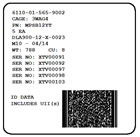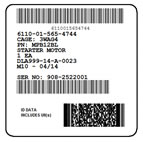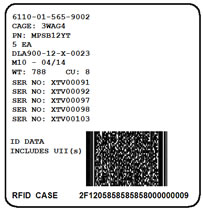IUID Container Marking
Mil-Std-129R requires that containers with UID-marked items include the UIIs in machine-readable format with the identification markings of the container. This is similar to the requirement for serial numbers. However, because UIIs may be up to fifty characters in length, encoding them with linear bar codes is not practical.
The use of a two-dimensional(2D) PDF417 for the purpose of representing UIIs in machine-readable format was introduced in Mil-Std-129P, Notice 4. The 2D symbol is a very dense data structure that allows it hold up to five UIIs along with all the other machine-readable data required for container labels. For exterior container labels, this could eliminate up to ten linear bar codes.
Revision R made use of the 2D symbol in place of linear bar codes the preferred practice. Use of linear bar codes is still allowed under Mil-Std-129R, where it makes sense to use them.
The rules for encoding more than five UIIs in a container label 2D symbol are similar to those for serial numbers, which is to say the first five(5) must be included in the 2D symbol. If more than five are in the container, use a UII List and state "UII LIST INSIDE". [¶5.4.1.2.2c]
There is no requirement to list the UIIs in human-readable format on container labels [¶5.4.1.1.2b]. However, it may be helpful to do so to ensure that the packaged part(s) match the container label without the need to scan the PDF417. However, with a maximum size of fifty characters, there may not be room on the label for the UII(s). Listing each part's serial number would serve the same purpose, and it is often the last component of each UII.
RFID Tagging of IUID Containers
RFID container tagging requirements include the need to report the UIIs of each container to WAWF, so coordination of IUID container labeling with RFID taging is important.
It is permissible to use an RFID-enabled exterior container (Case) label, and optionally print the RF Tag ID on the bottom, below the last Mil-Std-129R required element of the label.
It would also be permissible to use a generic RFID tag for this purpose, however, generating the RF tag at the same time as encoding the UII(s) into the PDF417 allows for easy aggregation of that data.






 © 1996-2014 Mil-Pac Technology, Inc. All Rights Reserved.
© 1996-2014 Mil-Pac Technology, Inc. All Rights Reserved.